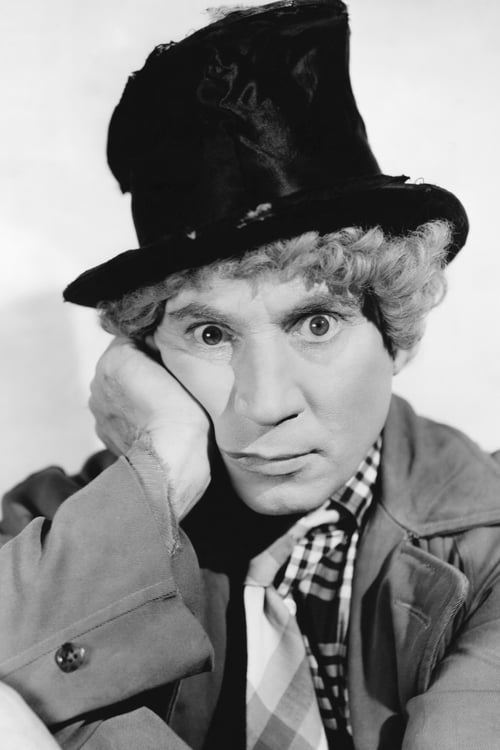Harpo Marx
Nascimento : 1888-11-23, New York City, New York, USA
Morte : 1964-09-28
História
Arthur Adolph "Harpo" Marx (November 23, 1888 – September 28, 1964) was an American comedian and film star. He was the second oldest of the Marx Brothers. His comic style was influenced by clown and pantomime traditions. He wore a curly reddish wig, and never spoke during performances (he blew a horn or whistled to communicate). Marx frequently used props such as a walking stick with a built-in bulb horn, and he played the harp in most of his films.
Description above from the Wikipedia article Harpo Marx, licensed under CC-BY-SA, full list of contributors on Wikipedia.

Self (archive footage)
Documentary - Take an in-depth look at the personal lives and careers of the famous Marx Brothers: Groucho, Harpo, Chico, Zeppo and Gummo. Pioneers on the American comedy scene, the brothers' comedic timing, wit and style are unmatched to this day. Fans will delight in this broad collection of Marx memorabilia, including favorites such as "Animal Crackers," "Monkey Business," "Duck Soup" and "A Night at the Opera," as well as interviews and rare footage. - Chico Marx, Groucho Marx, Harpo Marx

Self (archive footage)
Join all you favorites--Spanky, Buckwheat, Alfalfa, Darla, Butch, Froggy and more--in a jam-packed special covering more than twenty years and 200 episodes of Hal Roach's inimitable brand of childhood magic. This fascinating video offers insight into the Gang's personal lives, as rare footage follows each member's career through the joys and misfortunes that went along with being one of America's most beloved kids. See how the series began in 1922 and changed after the first all-talking release in 1929, why Shirley Temple and Mickey Rooney never made the Gang, a fifteenth anniversary reunion, and clips from their only feature.

Self (archive footage)
A tribute to the lives and careers of the Marx Brothers utilizing rare archival footage and personal interviews.
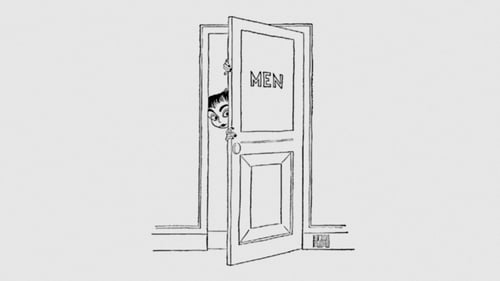
Himself (archive footage)
The story of the legendary wits who lunched daily at the Algonquin Hotel in New York City during the 1920s. The core of the so-called Round Table group included short story and poetry writer Dorothy Parker; comic actor and writer Robert Benchley; The New Yorker founder Harold Ross; columnist and social reformer Heywood Broun; critic Alexander Woollcott; and playwrights George S. Kaufman, Marc Connelly, Edna Ferber and Robert Sherwood.

(archive footage)
Robert Preston hosts this documentary that shows what people of the 1930s were watching as they were battling the Depression as well as eventually getting ready for another World War.

Himself (archive footage)
Out-takes (mostly from Warner Bros.), promotional shorts, movie premieres, public service pleas, wardrobe tests, documentary material, and archival footage make up this star-studded voyeuristic look at the Golden age of Hollywood during the 30s, 40, and 50.

Archive Footage
While a few Hollywood celebrities such as James Stewart and Clark Gable saw combat during World War II, the majority used their talents to rally the American public through bond sales, morale-boosting USO tours, patriotic war dramas and escapist film fare. Comedian David Steinberg plays host for this star-studded, 90-minute documentary, which looks at the way Tinseltown helped the United States' war effort.

(archive footage)
A fascinating look at the most beloved comedy team in motion picture history. Exclusive interviews with those closest to the brothers supplement this collection of highlights from their film, theater, and television appearances and offer a compelling look at their lives both on and off-screen.

Self (archive footage)
A collection of bloopers and outtakes from an enormous selection of Hollywood classic productions spanning from the 1930s through the 1980s.

(archive footage)
É a sequência de Era Uma Vez em Hollywood, de 1974. A produção mostra uma retrospectiva dos principais filmes produzidos pela MGM dentre os períodos de 1930 a 1950. Neste segundo documentário, arquivistas destacaram números musicais pouco conhecidos dos arquivos da MGM, e também tributos a alguns dos times de comédia mais famosos da MGM, como os Irmãos Marx, e Laurel e Hardy, duplas românticas como Spencer Tracy e Katharine Hepburn, e uma montagem de estrelas icônicas como Clark Gable, Mickey Rooney, John Barrymore, Wallace Beery, Joan Crawford, Jean Harlow, James Stewart, Lana Turner e Greta Garbo. Gene Kelly e Fred Astaire apresentam o filme e Kelly dirigiu as cenas introdutórias, como a volta dele à Paris, na qual foi rodada dois dos filmes mais famosos da MGM "Sinfonia de Paris" e "Gigi".
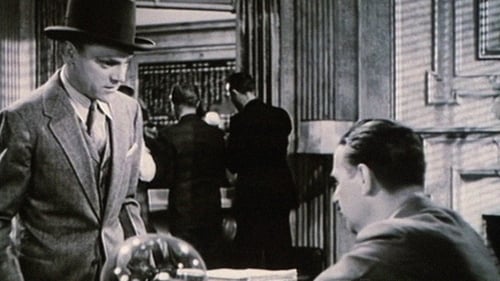
Self (archive footage)
Period music, film clips and newsreel footage combined into a visual exploration of the American entertainment industry during the Great Depression.
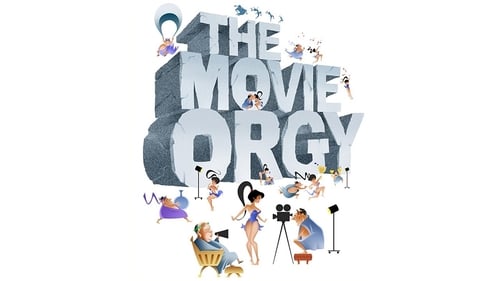
Self (archival footage)
Clips from assorted television programs, B-movies, commercials, music performances, newsreels, bloopers, satirical short films and promotional and government films of the 1950s and 1960s are intercut together to tell a single story of various creatures and societal ills attacking American cities.
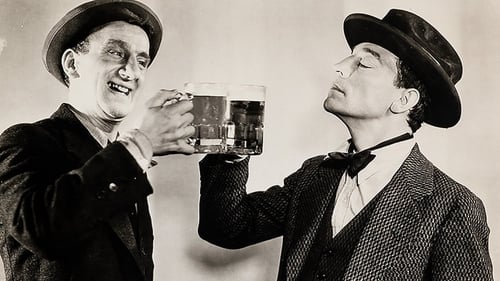
(archive footage)
Film clips highlight the funniest scenes and brightest comic stars in MGM's history.

Self
A collection of behind the scenes and home movies from the golden age of Hollywood.

Promotional movie for the Ford Motor Company. The movie is considered lost.

Nick
Jewel thieves Chico and Harpo Marx disguised as Groucho plan the perfect crime. Groucho appears as himself at the end in a police line up.

Sir Isaac Newton
The devil and the spirit of mankind argue as to whether or not humanity is ultimately good or evil.

Story
Mike Johnson, um empresário e dançarino, tenta produzir um show musical, ensaiando em um teatro com a dançarina Maggie Phillips, o Grande Faustino e a cantora Bunny Dolan. Para sustentar o grupo, o mudo Harpo rouba comida. Certo dia, ao roubar uma lata de sardinha, ele encontra diamantes contrabandeados por Madame Egelichi e seus comparsas, que farão de tudo para reavê-los. (e Livre - Estimado Livre)

Harpo
Mike Johnson, um empresário e dançarino, tenta produzir um show musical, ensaiando em um teatro com a dançarina Maggie Phillips, o Grande Faustino e a cantora Bunny Dolan. Para sustentar o grupo, o mudo Harpo rouba comida. Certo dia, ao roubar uma lata de sardinha, ele encontra diamantes contrabandeados por Madame Egelichi e seus comparsas, que farão de tudo para reavê-los. (e Livre - Estimado Livre)
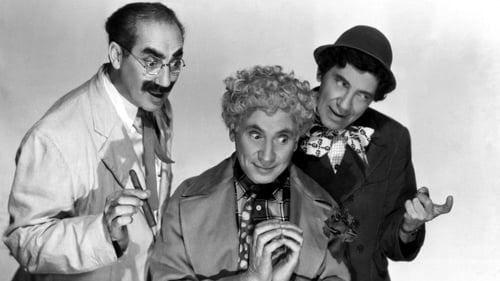
Rusty
The Marx Brothers are employed at a hotel in postwar Casablanca, where a ring of Nazis is trying to recover a cache of stolen treasure.
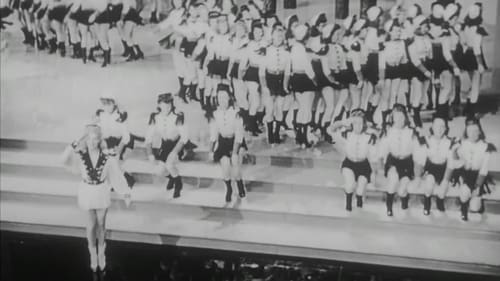
Self
Inspirational documentary short film featuring Hollywood stars promoting the sales of War Bonds through songs and skits.
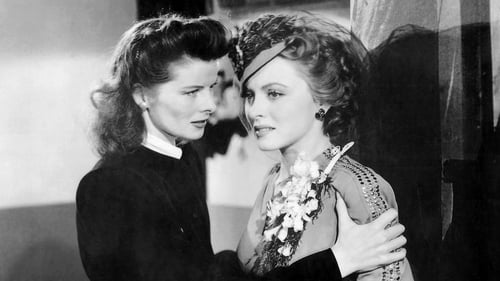
Harpo Marx
A young soldier on a pass in New York City visits the famed Stage Door Canteen, where famous stars of the theater and films appear and host a recreational center for servicemen during the war. The soldier meets a pretty young hostess and they enjoy the many entertainers and a growing romance
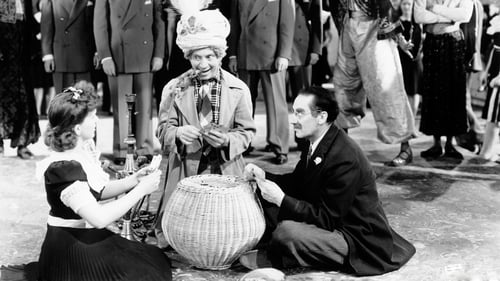
Wacky
Um detetive é contratado para proteger a vida de um cantor, que herdou recentemente uma loja de departamentos do trapaceiro gerente da loja.
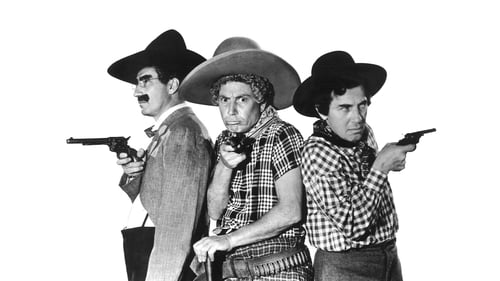
'Rusty' Panello
Os irmãos Marx se aventuram no velho Oeste. Joseph e Rusty ganham uma escritura como pagamento e usam ela para pagar cervejas. Mais tarde descobrem que precisam da escritura e tentam recuperá-la mas os bandidos vão tentar impedi-los a todo custo!

Self
Douglas Shearer, engenheiro de som da MGM, nos leva num passeio pelos bastidores para apresentar a forma como a parte de som de um filme falado é criada. Usa o filme Divino Tormento ou Bitter Sweet (1940) (Com imagens de Jeanette MacDonald e Nelson Eddy) e o filme O Inimigo X ou Comrade X (1940) (Com imagens de Clark Gable e Hedy Lamarr) para ilustrar as técnicas. Partes deste curta estão em Technicolor, incluindo um impressionante teste de tela de Greer Garson para o filme Flores do Pó ou Blossoms in the Dust (1941). O resultado é um "desfile" de trailers dos próximos filmes da MGM que mostram quase toda a constelação de estrelas da MGM.
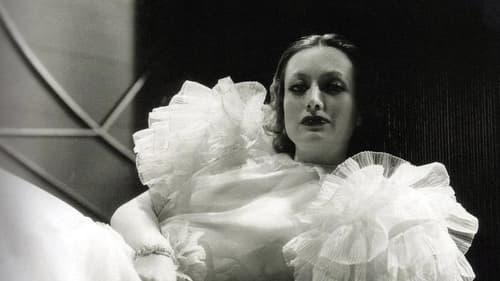
Self
This short promotes the premise that movies often create a demand for the fashions seen in them. It starts with a vignette in rural America. A mother and daughter go to town to buy a new dress. In the dress shop window is a designer dress worn by Joan Crawford in a recent movie. We then go to Hollywood and visit Adrian, MGM's chief of costume design, and see how multiple copies of a single clothing pattern are produced. The film ends with short segments of several MGM features.
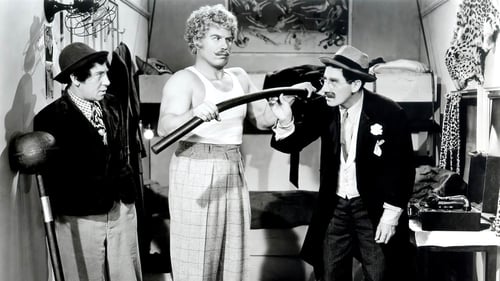
'Punchy'
Jeff Wilson, dono de um pequeno circo, deve US$10.000 ao seu sócio, Carter. Antes que Jeff consiga pagar, Carter permite que seus cúmplices roubem o dinheiro, para que ele fique com o circo só para si. Antonio Pirelli e Punchy, funcionários do circo, juntamente com o advogado Loophole, tentarão encontrar o ladrão e recuperar o dinheiro.

Self
An MGM short showing how materials are shipped by boat 'From the Ends of the Earth' to Hollywood. Featuring footage from the MGM films being made at the time. Such as The Women, Thunder Afloat, Siren of the Tropics, Ninotchka, Northwest Passage, and At the Circus.

Faker Englund
Os Irmãos Marx tentam montar uma peça de teatro antes que o gerente do hotel descubra que eles estão sem dinheiro. Para confundir o gerente eles fingem que o autor da peça contraiu uma doença terrível e não pode ser movido. Originalmente uma peça de teatro, o cenário mostra as suas origens, mas isso é dos Vintage Irmãos Marx.
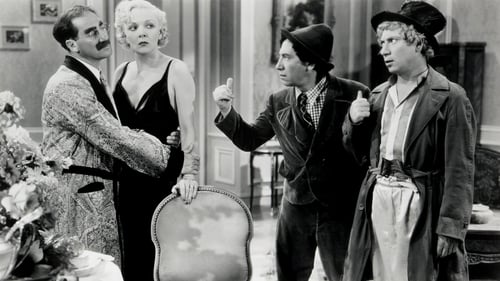
Stuffy
Em seu papel preferido, Groucho é o Doutor Hugo Z. Hackenbush - Dr., PhD, ABC, BBB, Zyb e mais um montão de siglas. Chico, Harpo e Margaret Dumont também participam desta comédia que é um verdadeiro coice no mau-humor. Divirta-se com um sorvete especial, o exame médico de Dumont, Harpo como uma bela garota e muito mais, à moda dos irmãos Marx.

Himself
La Fiesta de Santa Barbara is a 1935 American comedy short film directed by Louis Lewyn. It was nominated for an Academy Award at the 9th Academy Awards in 1936 for Best Short Subject (Color). It features a young, pre-stardom 13-year-old Judy Garland singing "La Cucaracha" with her two sisters (billed as "The Garland Sisters"). In the film, Hollywood stars participate in a Mexican-themed revue and festival in Santa Barbara. Andy Devine, the "World's Greatest Matador," engages in a bullfight with a dubious bovine supplied by Buster Keaton, and musical numbers are provided by Joe Morrison and The Garland Sisters. Comedy bits and dance numbers are also featured.
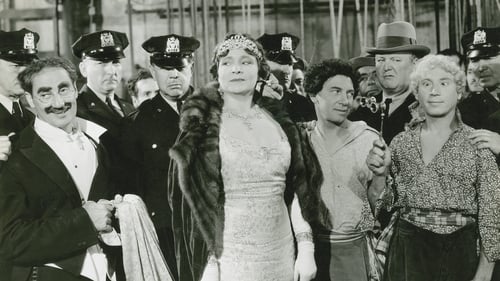
Tomasso
Dois amantes que gostam e trabalham com ópera estão distantes porque o homem não é bem aceito como tenor. Os irmãos Marx, então, fazem com que o tenor normal esteja ausente para o outro ter sua grande chance, através de muitas palhaçadas típicas do grupo.
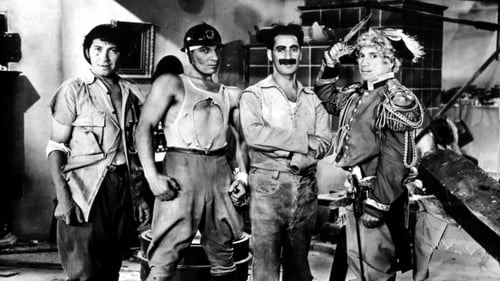
Pinky
Rufus T. Firefly é nomeado presidente/ditador da corrupta Freedonia e declara guerra à sua vizinha, Sylvania, disputando o amor da rica Sra. Teasdale.

Self
Short film made up of various clips showcasing the Cinecolor process, including a visit to a Marx Brothers film set.
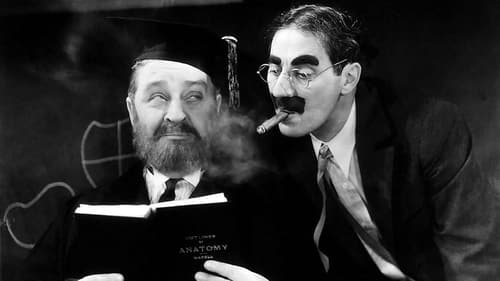
Pinky
O professor Quincy Adams Wagstaff (Groucho Marx) acaba de ser nomeado o Diretor da Faculdade Huxley. Seu filho Frank (Zeppo Marx), que está mais interessado em namorar do que estudar, sugere que ele incentive o time de futebol americano da escola. Tentando ajudar, o filho diz ao pai que os melhores jogadores do país costumam se encontrar num bar próximo à faculdade. Quando o professor chega lá, contrata dois esquisitões (Chico e Harpo Marx) achando que são ótimos esportistas. Essa dupla fará de tudo - menos jogar futebol.

The Merchant of Wieners
In the office of Mr. Lee, a talent agent, Zeppo bursts through the door, proclaiming to be a great musical actor. He gives a terrible impression of Maurice Chevallier. Chico arrives, also proclaiming to be a great musical talent, and gives an even worse impression of the same musical act. This is followed by Groucho and finally Harpo, all adding to the growing confusion in the office.
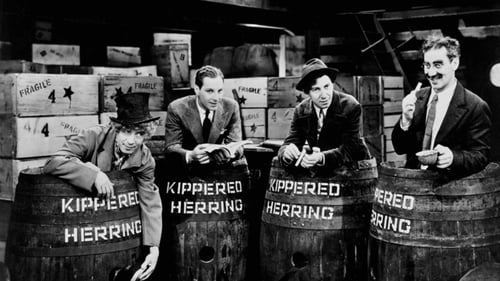
Harpo
Four stowaways get mixed up with gangsters while running riot on an ocean liner.

The Merchant of Wieners
The House That Shadows Built (1931) is a short feature, roughly 48 minutes long, from Paramount Pictures made to celebrate the 20th anniversary of the studio's founding in 1912. It was a promotional film for exhibitors and never had a regular theatrical release and includes a brief history of Paramount, interviews with various actors, and clips from upcoming projects (some of which never came to fruition). The title comes from a biography of Paramount founder Adolph Zukor, The House That Shadows Built (1928), by William Henry Irwin.
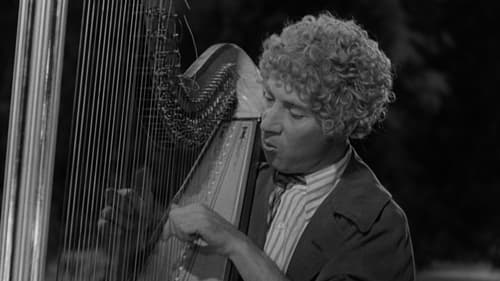
The Professor
Os Irmãos Marx levam anarquia à festa da alta sociedade em honra do explorador Jeffrey T. Spaulding, que volta da África e onde será exibido quadro caríssimo.
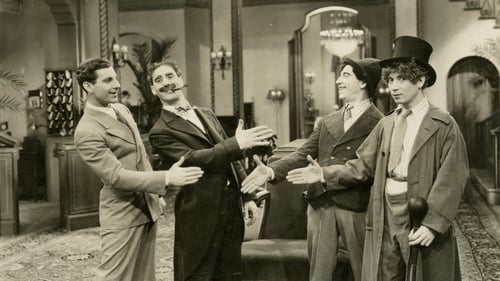
Red
During the Florida land boom, the Marx Brothers run a hotel, auction off some land and thwart a jewel robbery.

The Village Peter Pan
Wanting his son to get away from his many girlfriends and buckle down to work, the New York industrialist father of a playboy sends him to an obscure village in Spain to find samples of a rare mineral. When the son gets to Spain, he runs afoul of the local police chief - who has a secret that he tries to keep the young man from discovering.

Watson
Harpo played the hero, a detective named Watson who "made his entrance in a high hat, sliding down a coal chute into the basement". Groucho played an "old movie" villain, who "sported a long moustache and was clad in black", while Chico was probably his "chuckling [Italian] henchman". Zeppo portrayed a playboy who was the owner of a nightclub in which most of the action took place, including "a cabaret, [which allowed] the inclusion of a dance number". The final shot showed Groucho "in ball and chain, trudging slowly off into the gloaming". Harpo, in a rare moment of romantic glory, gets the girl in the end.
